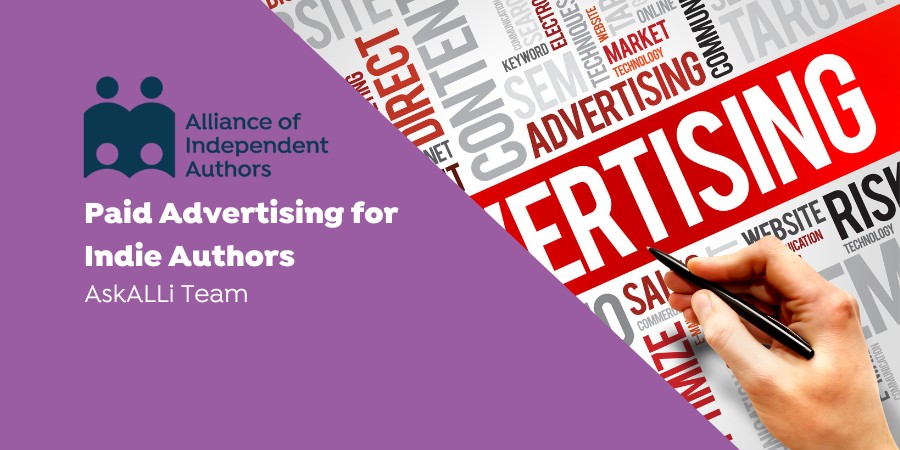As an indie author, you've poured your heart and soul into your book and spent countless hours writing, revising, and editing. Now, it's time to share your work with the world. But how do you get your book in front of readers? One effective way is through paid book advertising, which is what the Alliance of Independent Authors AskALLi team is exploring today.
Show us a successful independent author (or any other kind of publisher) and you're probably looking at somebody who has invested in some kind of paid book advertising i.e. paying a fee to promote your book on a particular platform or website.
Every publisher needs to drive traffic to your books and products in order to get sales. Book advertising is one effective way to do that. But that doesn't mean every author should run out and start purchasing ads.
While there are many different types of advertising any business owner can use, there are a few used more commonly for authors. There are many options available, each with its own pros and cons.
They include Amazon's innate advertising platform AMS. Meta advertising on Facebook and Instagram, Bookbub (both the Featured Deals and cost per click ads), and other paid newsletter services. Another, sometimes overlooked option that's really good for authors is advertising on a comparable author's newsletter.
We're going to take a closer look at how each of these work. But first… do not consider any advertising without first setting up a strategy. While paid advertising can be a valuable tool for increasing book sales and building your author brand, it can also be expensive. It's important to weigh the potential return on investment against the cost of the advertising campaign before committing to it.
Advertising Strategy
When setting up an advertising strategy as an indie author, there are a few key factors to consider:
- Your budget: Determine how much money you are willing and able to spend on advertising. Consider how much you can afford to invest in advertising and how it fits into your overall marketing budget.
- Your goals: Determine your advertising goals, whether that's increasing book sales, building your author platform, or generating buzz for a new release. Having clear goals in mind will help you choose the most effective advertising channels and messaging.
- Your target audience: Determine your target audience and where they spend their time online. This can include social media platforms, book blogs, and other online communities. Not every advertising platform works for every genre. It's important you understand where to find your readers so that you don't throw money away trying to reach an audience that just isn't there.
- Advertising channels: Consider the various advertising channels available, such as social media ads, book blogs, paid newsletters, and Amazon Advertising. Research the effectiveness of each channel, as well as the costs and logistics involved.
- Your message: Craft an effective advertising message that resonates with your target audience and supports your advertising goals. This can include eye-catching visuals, compelling copy, and a clear call-to-action.
- Timing: Promoting your book during a busy holiday season or during a popular book event may help to increase visibility and sales. Paid advertising can be particularly effective when you have a new release or a limited-time discount offer.
- Measuring success: It's important to track your book's performance during and after the promotion to determine its effectiveness. Determine how you will measure the success of your advertising strategy. This can include tracking metrics such as clicks, conversions, and sales, as well as conducting surveys or gathering feedback from readers. Look for book promotion sites that offer detailed analytics and tracking tools to help you measure the success of your book advertising.
Speaking of timing, many authors wonder about when the right time to begin making an investment in book advertising. No one can tell you exactly when that is, as it depends on several factors, including your goals as an author, your budget, and the state of your author platform.
If you're just starting out as an author and have limited resources, it may be more beneficial to focus on building your author platform and developing your writing skills before investing in paid advertising. This can include building a website, growing your social media following, and networking with other authors and industry professionals.
Once you have a solid author platform in place, you may consider investing in paid advertising to increase your book's visibility and reach a wider audience. Paid advertising can be particularly effective when you have a new release or a limited-time discount offer.
Readthrough
“Readthrough” is a word you'll hear book advertisers talk about a lot. This relates to books series and refers to the percentage of readers who reading another book in the series after finishing the first book. For example, if 100 readers start reading one book in a series and 50 of them go on to read the second book, the readthrough rate for that series is 50%.
Readthrough is an important metric for authors of book series, as it can indicate the level of reader engagement and interest in the series. A high readthrough rate suggests that readers are invested in the story and characters and are likely to continue reading future books in the series.
Readthrough is closely related to advertising for book series because it can help authors determine the effectiveness of their advertising campaigns. One of the undisputed facts about book advertising is the more connected books you have, the easier it is to make money.
By measuring readthrough rates, authors can get a better sense of whether their advertising is reaching the right audience and whether readers are engaged enough with the first book in the series to continue reading subsequent books. For example, if an author invests in advertising for the first book in a series and sees a high readthrough rate for subsequent books, this suggests that the advertising was effective in attracting the right audience and generating interest in the series. On the other hand, if the readthrough rate is low, it may indicate that the advertising failed to connect with readers or that there were issues with the book itself that turned readers off.
By tracking readthrough rates and analyzing the results of their advertising campaigns, authors can make informed decisions about future marketing and promotional strategies. They can use this information to refine their targeting, improve their messaging, and create more effective advertising campaigns that increase engagement with their book series and build a dedicated fan base over time.
If you've spent £2 in advertising to get a sale, and you only have a £4.99 book and you're making £2.35 on that sale, you're only netting 35p. Doesn't seem worth it but if that reader then goes on to read book two and three in the series, and they're also priced at £4.99, then you're making £5.05 in net profit.
Meta Advertising
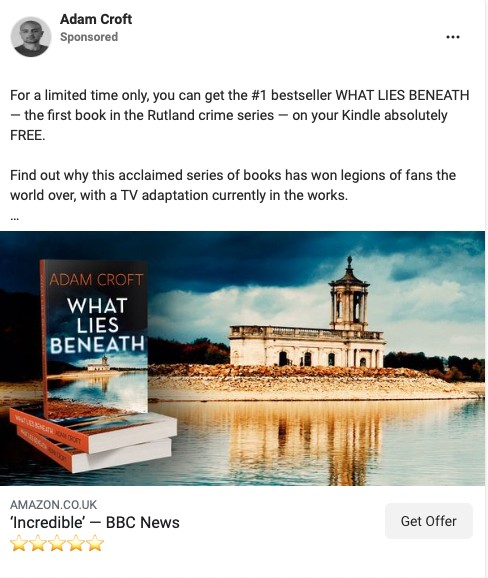
Example of Facebook Ad
Facebook and Instagram advertising are run and managed through Facebook's Meta Business Suite.
These ads work through a pay per click system. This means every time a Facebook or Instagram user clicks on your advert, you're charged. If someone sees your ad but doesn't click it, you're not charged for that exposure.
When building your ad, you choose a link you want to send users to. This is usually either:
- an Amazon book sales page
- a universal book link for wide authors
- a direct sales link to your own website store. This is the one that ALLi recommends unless you are using ads to drive yourself up a bestseller list.
The hope is that this then leads to a sale for you. If that sale happens on your own website, you then have the buyers email and you can sell other books to them in future.
Using Meta systems, you can target specific people who are a good fit for your books, via their interests (i.e. Reading, authors, movies, etc). You can also narrow those targets by adding additional demographic requirements like location, identity, the fact they follow your page, or they're on your mailing list.
You may use advertising to grow your followers, subscribers, or patrons.
One of the plus sides of Meta is that the platform has an enormous user base, therefore you're likely to find an audience. One of the downsides is that it's one of the more spend-hungry platforms and if you set a budget of £20, it will spend all of that £20 in one day. So you do need to be careful and watch for ad effectiveness.
Book Promotion Websites
Book promotion websites are online platforms that help authors promote their books to a wider audience. Some book promotion websites also offer paid promotional services, such as book feature listings, book reviews, and book giveaways, to help authors reach a larger audience.
There are a variety of book promotion websites available, each with their own focus and audience. These websites typically feature a range of book-related content, including book reviews, author interviews, book deals, and book recommendations but there are many kinds of websites and platforms, offering different features.
Some examples include:
- Kindlepreneur: A website focused on helping indie authors promote and sell their books on Amazon, offering a range of tools and resources for book marketing.
- The Fussy Librarian: A book discovery service that offers daily emails featuring personalized book recommendations based on readers' preferences.
- BookGorilla: A book promotion service that offers discounted book deals to readers, as well as promotional opportunities for authors.
- Book Riot: A book-focused website featuring book reviews, author interviews, and book-related news and commentary.
- IndieReader: A website focused on promoting and reviewing independently published books, offering editorial reviews, book feature listings, and author interviews.
- Written Word Media, an ALLi Partner Member, offers a range of book promotion services for indie authors, including book feature listings, email promotions, and author interviews, to help authors increase book sales and visibility. They operate four book promotion sites that have a good reputation among indie authors and are considered a reliable option for book promotion:
- Freebooksy: Promotes free ebooks to a targeted audience of readers.
- Bargain Booksy: Promotes discounted ebooks to a targeted audience of readers.
- Red Feather Romance: Promotes romance ebooks to a targeted audience of readers.
- NewInBooks: Features new book releases in a variety of genres, as well as author interviews and book recommendations.
However, as with any book promotion service, it's important to carefully consider the costs and potential return on investment before investing in their services.
Book promotion is an ongoing process, and it's important to be consistent with your efforts. Consider using book promotion sites in combination with other marketing strategies, such as social media marketing and author events, to build your author platform and increase book sales over time.
Book marketing guru David Gaughran conducts excellent research annually into the best paid newsletters in the industry. You can read all about the newsletters he chose for 2023 here.
What is Bookbub?
Bookbub is one newsletter mailing list for readers looking for discounted books that stands out from the crowd. Bookbub has audiences across a range of genres and readers located across the globe.
It has two main types of advertising options. Featured Deals and Bookbub Ads.
Bookbub Featured Deals
“Use Featured Deals to boost exposure and revenue by driving hundreds or even thousands of ebook sales. Our daily Featured Deal emails alert readers to free and discounted ebooks matching their genre interests. These limited-time deals are submitted by authors and publishers and curated by our expert editorial team specifically for our highly-engaged audience of book-buyers.”
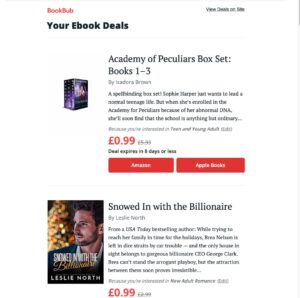
Bookbub CPM and CPC Ads
“BookBub Ads is an ad platform designed exclusively for authors and marketers to promote books of all formats to our members. Our self-serve display advertising platform is one of BookBub’s most flexible promotional options. You can run an Ads campaign at any point in your book's lifecycle with whatever budget you have available. With complete control over your targeting, ad design, spend, and timing, you can create a campaign tailored to your specific marketing goals. Ads are served through an auction, and appear in dedicated spaces in our BookBub and Chirp emails and on the BookBub website.”
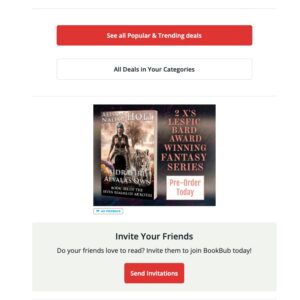
What is Amazon AMS Advertising?
Amazon is one of the biggest search engines on the internet. It's also one of the biggest digital bookstores, meaning readers are there to buy books. That immediately increases the chance of your advertising being successful.
AMS ads are run through Amazon's advertising dashboard. You can access it either through your KDP dashboard under each individual book or via ams.amazon.com. When you run an AMS ad, it appears on Amazon. For example, the books in the image below circled in a red ring are being advertised. They are marked by the “sponsored” label.
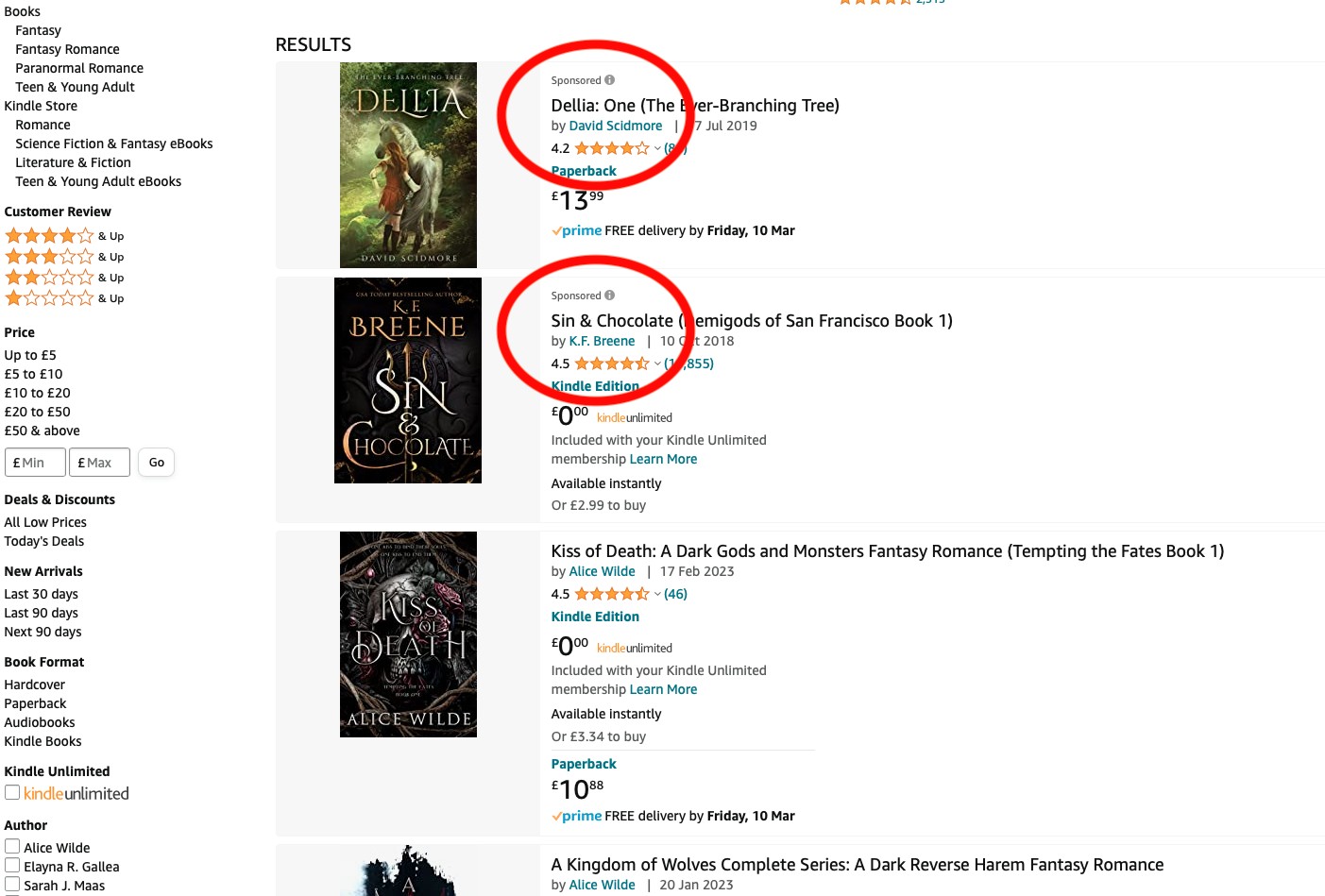
AMS ads marked by red rings and the word “Sponsored” after searching for “Fantasy Romance”
AMS ads can be targeted in a number of ways:
- Through the categories on Amazon you put your book in “books > ebooks> nonfiction > writing craft” etc
- Via key words which could be similar book ASINs, book titles, author names
- Auto ads. Amazon uses the data your book has produced to target books and products it think will convert to sales
- Lock Screen ads projected onto kindles lock screens
- Brand ads which allow you to advertise multiple products at once
One of the oft quoted benefits of Amazon ads is that it's a lower risk environment to experiment with because the ads won't always spend your budget, unlike some of the more spend-hungry ad platforms.
One of the downsides to Amazon ads is the reliability of the reporting system and the fact it underreports sales. Instead, many authors cross reference the number of clicks and spend they have in the AMS dash to the reported income in their KDP reports.
Paid Newsletters
getting advertising in the newsletter of another author in your niche can also be an effective way to reach new readers and promote your book. By finding authors whose audience overlaps with your own and creating engaging, relevant advertising content, you can build your fan base and increase your book sales.
When looking for newsletters to advertise in, it's important to find authors whose audience overlaps with yours. This can include authors in your genre or sub-genre, authors who write in a similar style, or authors who appeal to a similar demographic.
Once you've identified potential newsletters, you can reach out to those authors, or their representatives, to inquire about advertising opportunities. Some authors may offer sponsored content or ad space in their newsletters for a fee, while others may not have considered the option but are open to the idea. Expect to try a few people before hitting on the perfect partnership.
When creating your ad or sponsored content, it's important to keep it engaging and relevant to the audience. This can include offering an exclusive excerpt from your book, a special discount for newsletter subscribers, or a giveaway for a free copy of your book.
It's also important to track the results of your advertising efforts, including the number of clicks, conversions, and sales generated by the newsletter ad. This can help you determine the effectiveness of your advertising and make adjustments as needed.
There are a few things to look out for when considering advertising in someone else's newsletter. By considering these factors, you can ensure that your advertising efforts are effective and align with your overall marketing goals:
- Reputation and audience: Make sure the author and their newsletter have a good reputation and that their audience matches your target audience. It's also a good idea to research the author's past partnerships and their results.
- Ad placement: Ensure that your ad is placed in a prominent location within the newsletter, preferably near the top, to maximize visibility and engagement.
- Ad format: Consider the format of the ad, including the design and messaging. Make sure it is eye-catching and resonates with the audience.
- Cost and ROI: Determine the cost of the advertising opportunity and weigh it against the potential return on investment. Make sure the cost aligns with your budget and expected revenue.
- Legal compliance: Make sure your ad complies with advertising laws and regulations, including any applicable disclosures or disclaimers.
- Timing: Consider the timing of the ad placement in relation to your book launch or other promotional efforts. Make sure the timing aligns with your overall marketing strategy.
Paid book advertising is just one part of a comprehensive marketing strategy, and it should be integrated with other efforts such as social media marketing, email marketing, and content marketing to maximize its impact.

Rachel McLean, Author
ALLi Member Case Study Rachel McLean
I'd been running ads for three years and getting campaigns to work for a few weeks, after which they'd drop off and start losing money. In 2020, I pivoted to writing crime fiction. The ads were profitable from the beginning, and still are. I think there are three reasons for the big difference. 1. I'd done my research and knew what readers wanted (instead of writing books that fitted into no discernible genre and were just what I thought would be interesting). 2. I picked a genre with a huge market, meaning there's a big audience for my ads to get through. 3. My series are always growing, meaning a sale of book 1 in a series is now worth about $30 to me. That gives you a lot of scope for running ads.
What is your advertising strategy?
I start with FB ads as these will serve to any book and it doesn't matter how many conversions it's already getting. Once I get sales, I use Bookbub ads to tweak my also-boughts. I don't try to make a profit with these ads, just teach Amazon who is buying my books. That way, Amazon will recommend my books to the right people. Once I have three books out, I start running Amazon ads, again with a focus on targeting the right books so my also boughts are solid. I've been able to scale Amazon ads over time and they're now the backbone of my advertising.
Do you have an example of an effective ad?
My best ad was a FB ad with a quote from an Amazon review:
‘If you like Line of Duty, you'll love these books'.
Line of Duty is a hugely popular crime show in the UK with millions of viewers. I ran the text over a background image of a police car (after testing lots of images). I thought that ad would work while series 6 of the show was on, but it actually ran as a profitable ad for 18 months and probably earned four times what I spent on it over that time.
Do you have a tip for choosing effective targets?
Find books that are selling just above what your short term goal is. When your sales increase, raise your sights and find other targets with better rank. Don't try to target the bestsellers when you're starting out: they're too competitive. Watch the charts and your own rank and tweak as you go. Your targets should also be in your genre, and ideally indie, or at least published by a small or digital-first publisher.
Do you have any tips for writing effective copy?
I'm not an expert on this, so I learned from people who are! I can recommend Elana Johnson's ‘Writing Killer Cover Copy' which was really useful.
What mistake you see writers making with advertising?
Not doing any research before they start writing. If you're going to write something people want to read, you have to understand what it is they love reading. Read other authors' reviews, look at the charts, and find out what people love in your genre. Write to be read.
Is there anything you wish you’d known before?
Don't try and write a very depressing dystopian novel in the hopes of Margaret Atwood fans buying it! That book was no fun to write and barely sold.
Rachel McLean writes British crime. You can find out more about her on Facebook, Twitter and her website.
ALLi Member Experiences
Christy Jackson Nicholas

